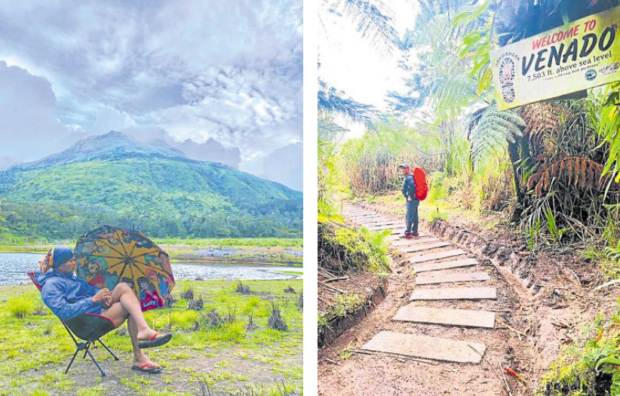
SCENIC, SAFE CLIMB | A mountaineer takes a break beside Lake Venado en route to Mt. Apo’speak. On the right, the Kidapawan City government says the concrete pathways built along theMandarangan trail leading to Apo’s summit aim to prevent soil erosion and ensure the safetyof climbers. (Photos courtesy of Carlo Delute and Meloy Oreject)
KIDAPAWAN CITY, Cotabato, Philippines — Environmentalists have protested the city government’s initiative of putting concrete blocks as pathways along a portion of Kidapawan trail to Mt. Apo, the country’s highest peak.
Critics took to social media to deride the project as “Stairway to Mt. Apo.” The pathway was built within the Mandarangan trail leading to Lake Venado, which is halfway to the peak.
Netizens raised concern about the destruction of the natural state of the trail due to the concrete slabs. However, a number of mountaineers credit the slabs for easing their climb amid the slippery trail.
“The purpose is commendable [because] the safety of climbers is a priority,” said lawyer Ermelo Libre, former director of the Mount Apo Foundation Inc.
But Libre hoped that “the environmental and cultural architecture must be incorporated in project construction to reflect the spirit of the natural surrounding environment and as an expression of the cultural tradition and aspirations of the indigenous community that was there before us.”
City information officer Psalmer Bernalte defended the project, saying there was a need to put up the pathway to prevent soil erosion along the trail.
Bernalte said trails leading to Lake Venado had been hit by erosion following the increased influx of climbers.
“Since the trail was already not safe to use (due to soil erosion), trekkers look for another way [to the peak] that requires them to damage plants in the mountain,” Bernalte said.
No law violated
He noted that the concrete rectangular pathways, which are less than 4 meters long, “is a big help in preserving the mountain’s flora and fauna from any human activities while trekking to the peak.”
Pathways will be established in all five areas of the Mandarangan trail, an initiative that was unanimously approved by the Mt. Apo Protected Area Management Board (PAMB) and the City Development Council, Bernalte said.
According to city tourism officer Gillan Lonzaga, the project costs at least P500,000 and is constructed by work teams from the City Engineering Office.
Bernalte said that while the city government welcomes constructive criticism, they will still push through with the project as it did not violate any environmental laws.
Mt. Apo, which stands at 2,954 meters above seal level is a favorite destination of mountaineers, especially during summer. It can be reached through six trails starting from Kidapawan, Makilala, and Magpet in Cotabato province, and Digos, Sta. Cruz and Bansalan in Davao del Sur province.
The PAMB had set a daily limit of 50 trekkers per trail in 2017 following a fire in 2016 that damaged some 300 hectares of forest and grasslands, an incident blamed on an unattended campfire.
Trekking and related activities help support the livelihood of hundreds of porters and tour guides in communities around Mt. Apo.

